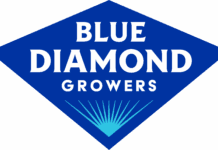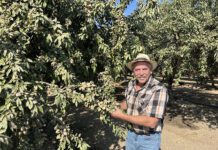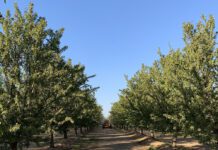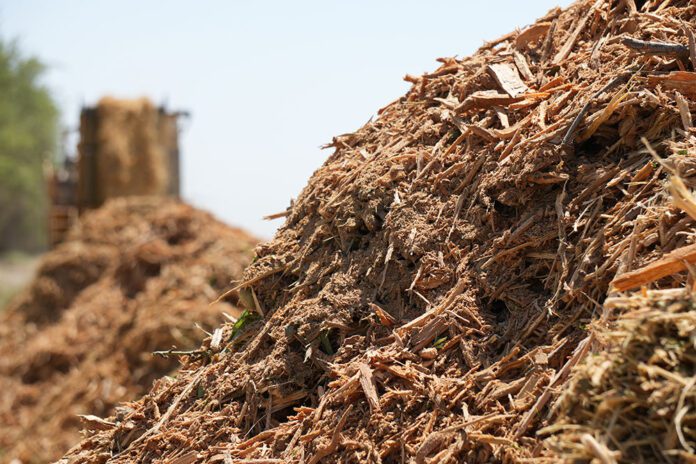
Listen to the audio version of this article. (Generated by A.I.)
With environmental stewardship a key consideration with food brands, consumer preferences, and California policy, the almond industry has made it a priority to ensure the positive efforts being made by growers are accurately and widely represented.
Almond Board of California (ABC) is working closely with the industry to develop a strategic approach to communicating almond stewardship that both protects its reputation and drives global demand.
“Food brands are concerned about sustainability and the environment,” said Danielle Veenstra, senior manager of global stewardship at ABC and third-generation almond grower, “because of many reasons, such as investor pressures, new state and European environmental disclosure laws and, of course, consumers.”
Simultaneously, the almond industry is no stranger to scrutiny. In a crowded media landscape filled with competing narratives and, at times, misinformation, providing accurate and compelling stewardship communication requires a strategic approach and data to back it up. That’s why ABC has invested in research, educational materials and grower resources to ensure the story demonstrates stewardship and continued innovation in how growers manage their orchards.
Building a Strategy Around Trends, Data and Audiences
To sharpen the marketing strategy, ABC commissioned a study from Deloitte, which assessed emerging markets and consumer trends, including how stewardship messaging influences almond demand worldwide. The findings reinforced what ABC suspected: Sustainability matters greatly to consumers, companies, policymakers and a growing group of thought leaders.
The category of thought leaders is a newer focus for the almond industry, Veenstra explained. These are the individuals often behind the scenes shaping conversations on climate, agriculture and environmental justice.
In 2024, ABC deepened its engagement with this group by participating in Climate Week in New York City, a first for the organization. The experience offered valuable insight into where key conversations take place, how the almond industry can have a seat at the table and an opportunity to share the California almond industry story directly with thought leaders.
“It’s important to be where the conversations are happening,” Veenstra said. “We can’t afford to sit on the sidelines when others are shaping the narrative for us.”
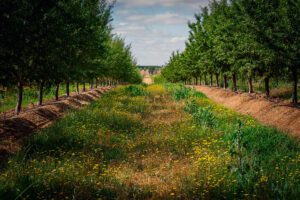
Environmental Stewardship Resources
A core part of the industry’s communications efforts are concrete assets and resources supported by ABC’s extensive production and environmental research programs. These infographics, supported by grower participation in the California Almond Stewardship Platform (CASP), are designed to communicate tangible and easy-to-read messaging to key audiences among food companies, media and policymakers about the stewardship of the almond industry.
“[The resources] talk about water, zero-waste, biodiversity, our community and local impact, and it really represents great data that the industry has provided,” Veenstra said.
One standout highlight is the carbon-storing capacity of California’s almond orchards, which sequester roughly 30 million metric tons of carbon, enough to offset the equivalent of the annual emissions of more than 3,000 Boeing 737 jets, 24.5 million gas-powered passenger vehicles or 29 coal-fired power plants.
Veenstra emphasized the impact.
“Removing carbon from the atmosphere is an important and critical strategy to address climate change. The almond industry, through its production and harvesting, is doing its part.”
Another outreach material recently launched by ABC is new almond snack packs with QR codes linking to educational content about how almonds are not only good for consumers, but also good for the planet. ABC distributes these packs at industry events, partner meetings and other consumer-facing opportunities to address common concerns around water use, pollinator health and waste, as well as providing a tasty, nutritious snack.
A Four-in-One Crop
ABC is also capitalizing on the industry’s ability to turn one crop into four products. In addition to the edible kernel, almonds produce hulls, shells and woody biomass, each with valuable uses and offsets. For example, using almond hulls in dairy feed reduces the need to grow alfalfa, thus conserving water.
“That offsets about 440 billion gallons of water, enough for 4 million households,” Veenstra explained.
This kind of circular thinking is what supports broader claims of California being the right place to grow almonds under some of the world’s highest standards.
“It’s one of only five places in the world with a Mediterranean climate,” she said. “It’s our responsibility to figure out how to do it right and how to do it responsibly.”
Water Research
The almond industry has long been a target of the water debate in California, often labeled as water-intensive without recognizing improvements with efficiency. That’s why irrigation and groundwater recharge research is a top priority at ABC, said Josette Lewis, ABC’s chief scientific officer.
“We have a long-standing history of funding irrigation research and turning that into practical tools that growers have put into practice in their operations,” she said.
One new tool recently used satellite data to show that almonds are not the thirstiest crop on a per-acre basis among California’s major commodities, helping push back against misleading narratives. As important, ABC also actively invests in peer-reviewed research to build credibility and avoid greenwashing claims, Lewis explained.
“Having published scientific data is a really powerful tool in environmental stewardship, just as it is in our production research,” she said.
Partnerships That Build Credibility
Another way ABC is building its credibility in the sustainability space is by partnering with aligned third-party organizations to deliver one-on-one support to growers and help develop external advocates for the industry.
One area of success has been in pollinator health. At one time, growing almonds faced criticism for its potential harmful impact on bees. In response, the industry launched collaborative efforts to improve conditions for pollinators, including planting cover crops and creating permanent habitats.
Studies have shown that because of these efforts, all tracked through CASP, honey bees are actually leaving almond orchards healthier than when they arrived.
“More than 21% of orchards in our California Almond Stewardship Platform now include blooming cover crops,” Lewis said. “And through Bee Friendly Farming, we’ve added over 35,000 acres of permanent habitat on almond farms.”
Thanks to CASP, the almond industry can consolidate environmental performance metrics across hundreds of farms. Grower participation is among one of the highest rates compared to other U.S. commodities, helping the industry track and communicate its stewardship practices, Lewis explained.
Shifting the Narrative
ABC’s stewardship efforts reflect a broader commitment, and that’s to demonstrate that California is the ideal place to grow almonds, not only because of its high standards, but because 90% of the industry is made up of family farms deeply invested in the crops they grow.
To continue driving global demand for California almonds, growers remain resilient stewards, meeting challenges head-on and consistently exceeding expectations. At the same time, ABC is committed to amplifying their efforts and reshaping the narrative to strengthen support for growers.
“This industry has a really holistic and substantive story to tell,” Veenstra said. “We’re going to continue to substantiate that, shift the narrative and use this to continue to drive demand and improve how we farm.”
References
Environmental Stewardship Resources: almonds.com/tools-and-resources/environmental-stewardship
QR Code Shares Almond Stewardship Story: almonds.com/almond-industry/industry-news/marketing-bulletin-january-2024-qr-code-shares-almond-stewardship
California Almond Stewardship Platform: almondstewardship.org/







